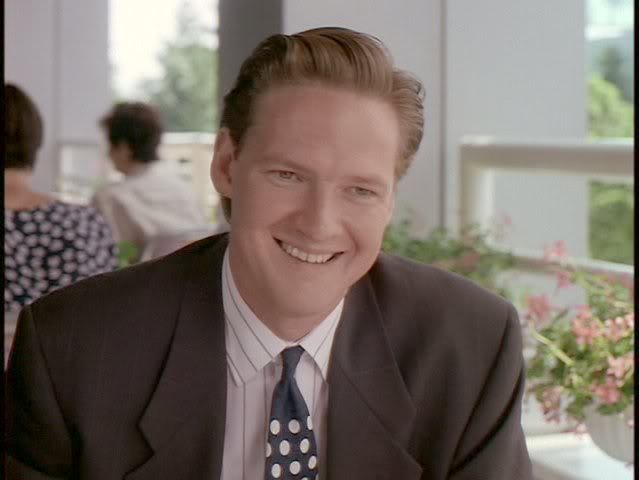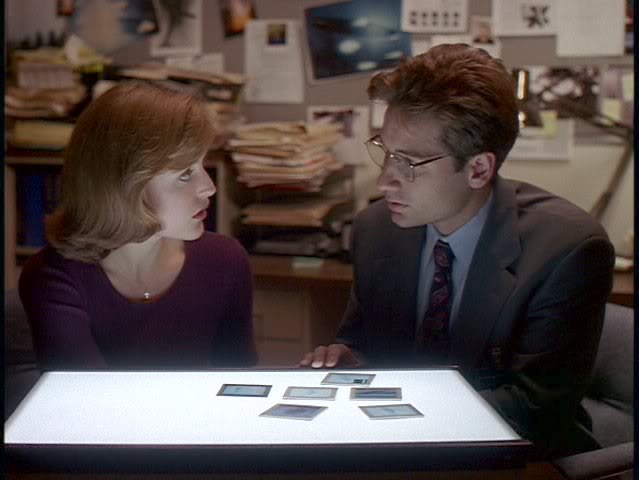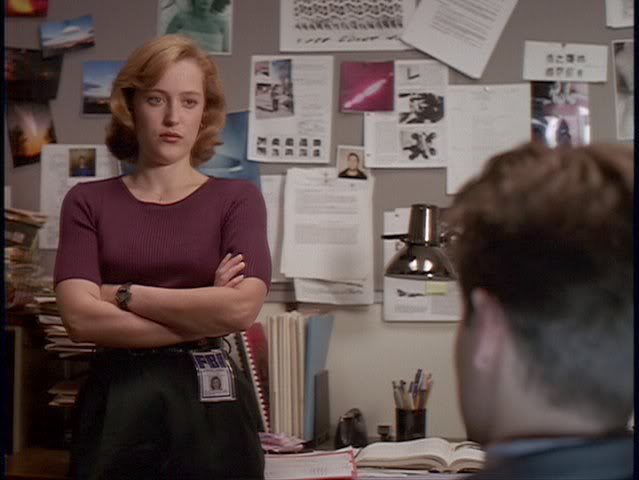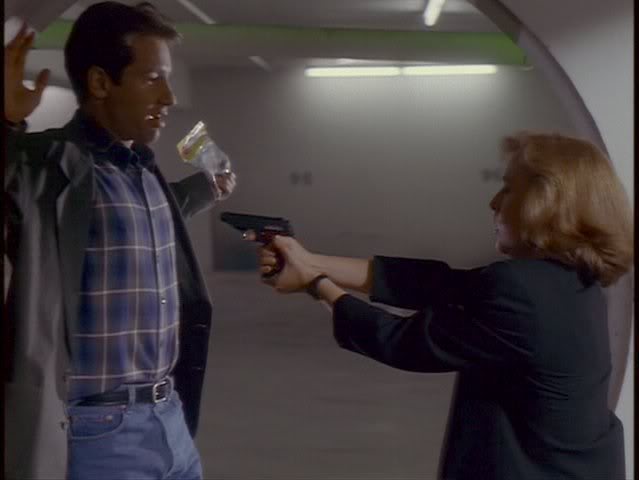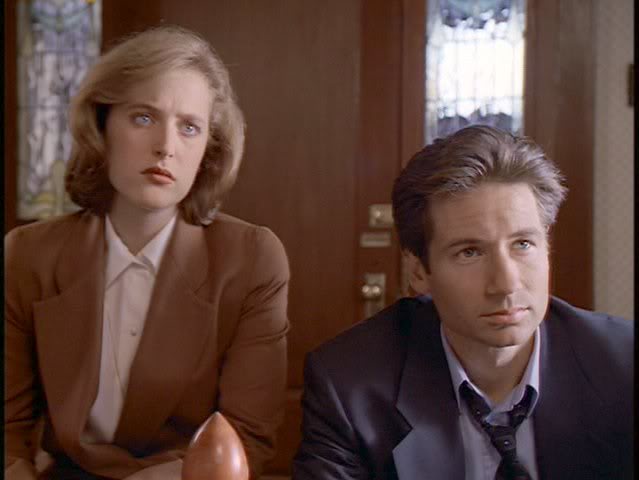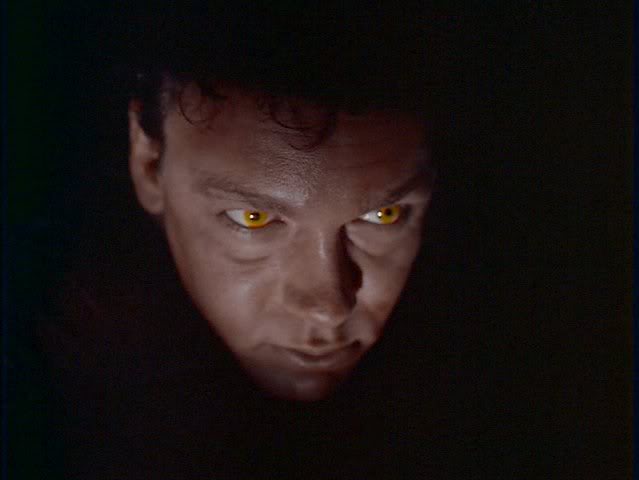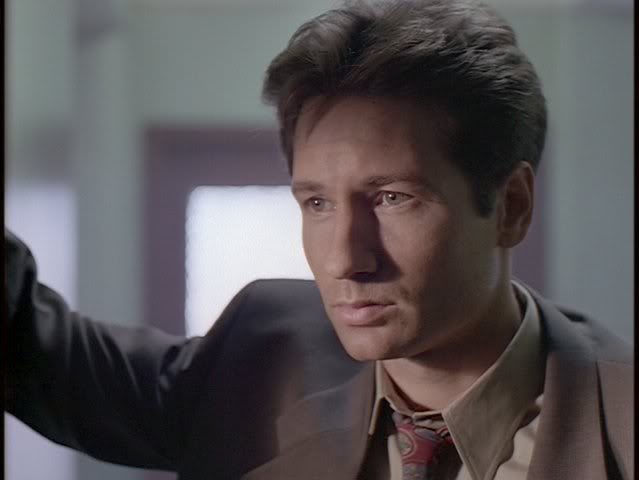REPOST -- CTP Episode of the Day - 04.10.06 - Squeeze
Today's Cherished Episode: Squeeze (1x02)
Original Air Date: September 24, 1993
Written By: Glen Morgan and James Wong
Directed By: Harry LongstreetMulder and Scully try to stop a mutant killer, Eugene Tooms, who can gain access through even the smallest spaces and awakens from hibernation every 30 years to commit murder.
"Do you think I'm spooky?"
Some "Squeeze" Tidbits and Musings:
-- "When I created The X-Files, I knew I wanted to give the viewer a roller coaster ride that they couldn't get off of for an hour," recalled Chris Carter. "I also knew I wanted it to depart from the UFO/extraterrestrial storylines as soon as possible, because I knew that the story couldn't sustain itself just by telling that kind of story." Probably a good thing that Carter felt that way; when the first two episodes of the show involved UFOs, FOX put the pressure on the series creator to come up with a different sort of story for the series' third hour. "Squeeze" not only helped establish that the show could be about more than just aliens each week, it also set the bar pretty high for all the "monster of the week" episodes (or MOTWs as the fans came to call them) that followed for the next nine years.
-- "Squeeze" was the first episode written by the legendary team of Glen Morgan and James Wong, whom Carter hired with the help of Peter Roth, former president of Stephen J. Cannell Productions who worked with the duo on such shows as 21 Jump Street and Wiseguy.. Roth left Cannell Productions to become president of TV production for 20th Century Fox; and it was Roth who signed Chris Carter to a development deal in 1992, along with a number of other relatively unknown producers. Morgan and Wong also served as co-executive producers and brought considerable production know-how to the party. Carter also hired the team of Howard Gordon and Alex Gansa, whose credits included CBS's acclaimed series Beauty and the Beast, to write and serve as supervising producers of the show. Those three writing units (Carter, Morgan/Wong, Gordon/Gansa) essentially accounted for 20 of the 24 episodes of the first season.
-- "Honestly, I thought our role on The X-Files, when we were just the hired help, was more fun than when we later became bosses on our own show (Space: Above and Beyond)," said Glen Morgan. "Back then, we'd be hanging out in Chris Carter's office, and there we could be a consigliore, whispering advice in Chris's ear. Then we'd go out of the office, and Chris actually had to take the heat."
-- Morgan recalled that during the show's first season, while most Fox television executives were preoccupied with other shows they deemed more commercial, the X-Files writing staff was able to cast a unique mold for the series that led to its enormous popularity. "Pretty much the prevailing idea of how to run a series is that if your pilot goes well, then the first six shows should be the pilot done six times over so that everybody knows who the characters are, what the situations are, all that stuff," said Morgan. "Because Fox was spending all their money and attention on Brisco County, Jr., on The X-Files we were all off doing our own thing."
-- This led to enormous freedom for the writing staff, but also some headaches. "There were a lot of times I didn't know what Howard and Alex were doing until I read their scripts," Morgan said. "Everybody was just doing their own thing. So on The X-Files, the first six episodes were all really different and that worked. Jim and I applied that lesson to Space, and we'll apply it to any other series we work on. We'll have ideas for the first six episodes, and it won't be the pilot six times over."
-- Although there were some parallels to The Night Strangler -- the second Night Stalker movie, which involved a man who rose to commit multiple murders every 21 years -- writers Glen Morgan and James Wong drew their inspiration for "Squeeze" from Jack the Ripper and a large ventilator shaft outside their office. As Morgan recalled, the episode started with a simple premise when he asked Wong, "What if we were working here late at night and some guy came *through* that thing?"
-- Morgan had also read an article about Richard Ramirez, a convicted serial killer who terrorized California in the first half of the 1980's. Before his capture, it was rumored that Ramirez entered the homes of his victims by the small window in the bathroom. This rumor would later be debunked after Ramirez's arrest, but the story intrigued Morgan so much that it was in part the basis for the creation of the character Eugene Victor Tooms.
-- Coincidentally, Ramirez was dubbed the "Night Stalker" by the media because he always attacked at night, like a vampire. In a further X-Files coincidence, a 1989 TV movie titled Manhunt: Search for the Night Stalker featured an actor named Gregory Norman Cruz as the serial killer; Gregory Norman Cruz played Diego Garza in the Season 8 X-Files episode "Vienen."
-- Chris Carter attributed most of the success of "Squeeze" to the fact that Morgan and Wong "cast a great actor" -- Doug Hutchison -- to play the part of the monster Eugene Victor Tooms. "It also helped that Hutchison was as scary as the character he was playing," chuckled Carter.
-- Hutchison became Eugene Victor Tooms when his agent sent him to read for the role in "Squeeze." When he showed up for the audition, Morgan thought he was too young to play Tooms; he felt the actor looked about 12 years old.
-- But Hutchison auditioned anyway. "I went into the room, and Harry Longstreet, the director, and the producers were there," he recalled. "We started to plunge into this interrogation scene, and Harry said, 'I'd like you to do this without any emotion.' So I'm thinking, 'Oh great, I'm just going to sit here and say yes, no, and be emotionless.' So I did it. And afterwards he said, 'Okay, that's very good, and now I'd like you to show me that you can be this serial killer. Pretend that you're stalking your victims. I just want to see your potential for evil.' And I'm thinking, 'What is this? This is ridiculous! What does he want me to do? Make a face, or what?' So I sat and I pondered his direction and as I was thinking about it, he must have thought that I misunderstood and he said, "Do you understand what I'm saying?" And it just jumped out of me before I knew it came out, but I said 'Yeah, I got it -- you want me to stalk you, you motherf---er???"
-- The director may have been taken aback, but producers/writers Morgan and Wong loved Hutchison's repressed intensity and immediately proclaimed, "That's our guy!" Longstreet took some convincing, but the producers knew they had their man.
-- "Harry Longstreet didn't like me," recalled Hutchison. "I intimidated him in the audition and he didn't want to work with me. Morgan and Wong cast me despite Harry's reservations, so I think he might have resented that. Consequently, Harry pretty much left me alone on set which was fine with me. David Nutter [who directed "Tooms"], on the other hand, was very much hands-on and came to the set with energy and fresh ideas. I enjoyed his direction very much. We had fun together."
-- Hutchison also had fun working with Duchovny and Anderson on "Squeeze." "It was only the third episode of the show," he said. "David and Gillian were both friendly, personable, humble, energetic, and approachable. By the end of the first season, when we were shooting 'Tooms,' both actors were exhausted from work and seemingly overwhelmed by the popularity of the show. I saw Gillian at a convention about a year later. She barely spoke two words to me. Ah, the bittersweet transformations of success."
-- Hutchison came to fall in love with the character of Tooms. "It was a very sweet challenge for me," he said. "I'm a very animated person, and I tend to bring a lot of animation to my roles. This was a particularly good challenge because I felt there was a stillness to this character. I had been intrigued by stillness for quite a while since seeing Anthony Hopkins as Hannibal Lecter in The Silence of the Lambs. He captured the art of stillness so well, and I was inspired by his performance."
-- Hutchison grew up in Detroit intending to become a rock musician. When a teacher convinced him to try acting, he moved to New York to study at the Julliard School. But the free-spirited actor soon realized he wasn't cut out for formal study, and dropped out of school, becoming active in New York and regional theatre. A disastrous musical, Shout and Twist, brought him back to Los Angeles, and he decided to remain there after that "nightmarish" experience to pursue film work. He soon landed roles in episodic television and in the feature films Fresh Horses and The Chocolate War.
-- After appearing on The X-Files, Doug Hutchison went on to appear on every show that Morgan and Wong worked on. He has also found steady work in films, appearing in A Time to Kill, Con Air, The Green Mile, I Am Sam, and The Salton Sea, and in television, with guest or recurring roles on such series as Party of Five, Murder She Wrote, The Practice, C.S.I., C.S.I. Miami, and Law and Order: SVU. His most recent work was a recurring role on the quickly cancelled NBC series Kidnapped, which starred Jeremy Sisto, Dana Delaney, and Timothy Hutton.
-- Chris Carter's contribution to this episode was limited to having just returned from France where he had eaten a lot of foie gras, which made him wonder what it would be like if someone developed a taste for human liver. Morgan said he and Wong settled on the liver because it was "funnier than any other organ."
-- It was a stretch (no pun intended) for Doug Hutchison to play a man who harvested livers from his victims; at the time, in real life he was a vegetarian. After filming "Squeeze," Hutchison sent Carter a gift-wrapped frozen calf's liver to thank him for the opportunity to play a character on The X-Files. "I thought it would freak him out," Hutchison said, "but Chris ended up rehiring me for 'Tooms,' so I guess either (a) he enjoyed the liver, or (b) the ratings for "Squeeze," were high enough to justify the liver."
-- At the time "Squeeze" was filmed, it was rumored that the director Harry Longstreet did a terrible job -- that he did not shoot enough takes and did not giving the editor many choices. (The rumor was substantiated by Jim Wong in an interview he did several years later -- see Wong's quote at the end of this CTP.) This probably explains why "Squeeze" has more "oopsies" than your average X-Files episode. A few of them will be pointed out here.
-- Timeline: The timeline for this episode wasn't actually established in the episode itself; it was established 18 episodes later in "Tooms." Tooms was arrested by the FBI about halfway through "Squeeze"; and when Skinner read Tooms' file in that later episode, the date for the arrest was given as July 23, 1993.
-- In fact, that July 1993 timeline was one of the things that frustrated X-Files fans in the early days of the show. If the date stamp of the "Pilot" were to be believed, Mulder and Scully would have been working together for more than a year when the events of "Squeeze" took place. However, references in "Squeeze" and other first season episodes that followed made it fairly obvious that the Mulder/Scully partnership was brand new. Thus, most X-Philes assumed that the "Pilot" date was the problem, and it should be considered that Mulder and Scully were officially partnered in March 1993, not 1992.
-- Oopsie! George Usher, the victim killed in the teaser, had some unusual items on his desk including a snow globe that he took great pains to shake so that viewers would recognize it among Tooms's "trophies" later on in the episode. But Usher also had a hippo figurine on his desk -- a hippo that moved from its place beside the telephone to the other side of the desk under the lamp between shots.
-- When the hippo moved to the other side of the desk, it was replaced by a Baltimore Colts coffee mug, appropriate as the episode took place in Baltimore, a city still bitter over the loss of their beloved football team. Almost as soon as the 1983 season was over, Colts owner Robert Irsay began talking to other cities about moving the club from Baltimore. He spoke to officials in Indianapolis and Phoenix, even as the Maryland legislature tried to use eminent domain laws to force the franchise to remain in Maryland. On March 28, Phoenix dropped out of the bidding, and Irsay called officials in Indiana to say the team was on its way. However, he kept the move secret until just after midnight when by cover of darkness on a cold, snowy night he used Mayflower moving trucks to pack up the Colts offices and relocate them in Indianapolis. To make matters worse, the Irsay family would not relinquish the name "Colts" as they had once promised to do, further angering Baltimore Colts fans and former players, including legendary quarterback Johnny Unitas. The city of Baltimore would fail in several attempts at landing an NFL franchise before it welcomed the new franchise named the Ravens in 1996.
-- Oopsie! While there was blood splattered all over his office, the only blood viewers saw on the body of George Usher (in his reflection in that Baltimore Colts coffee mug) was on his neck. It must have been pretty difficult ripping out his liver through his neck and managing to keep his shirt spotless.
-- Colton's remark about his and Scully's colleague lucking into the World Trade Center bombing was a reference to the attack on the World Trade Center that took place on February 26, 1993, when a car bomb was planted in the underground garage by Islamic extremists.
-- Oopsie! Scully's knife had a mind of its own during her lunch discussion with Tom Colton. First, she dropped it flat on the table, and in the next shot it was propped on her bread plate. A few moments later she was holding the knife, and when the shot changed it was back on her plate.
-- During her lunch with Colton, Scully mentioned his profile on the Washington Crossing killer. Although the "killer" part was most likely fabricated by Morgan and Wong, Washington Crossing is a national historic park in Pennsylvania. From that site, General George Washington and men of the Continental Army and militia crossed the Delaware River on Christmas night 1776 and marched to Trenton, New Jersey. There they attacked and defeated Hessian troops quartered in and around the village. This surprise attack and victory set the stage for Washington's subsequent victories at the Second Battle of Trenton and Princeton. The Crossing and the Trenton/Princeton campaign have become known as the Ten Crucial Days — a campaign that saved Washington's army from defeat, allowing them to fight another day and achieve ultimate victory.
-- Oopsie! Lack of footage probably explained why what looked like a flubbed line by Gillian Anderson was kept in the finished product. When Scully was introducing Mulder and Colton for the first time, she started to call Mulder "Tom," and then corrected herself.
-- Mulder told Scully about fingerprints lifted from Powhatan Mill in the 1930s, but any evidence that Powhatan Mill existed in the 1930s is non-existent. The name "Powhatan Mill" was likely taken from the Powhatan Cotton Mill, founded in 1810. It was located along Windsor Mill Road in the mill village of Powhatan, which existed just outside today's Baltimore City limits. It was never a very successful operation, and under several ownerships suffered through the panics and crashes of the 19th century. Devastating fires eventually brought an end to the operation in 1895. In 1902, the Woodlawn Cemetery Company bought the property and Woodlawn Cemetery was established on it on Gwynn Oak Avenue.
-- If you look closely you can see a picture of the corpse of Laura Palmer from Twin Peaks in the scene where Mulder showed Scully the elongated fingerprints from the previous murder scenes. It was hanging behind Scully's head when she backed away in her chair and stood up. David Duchovny played a small part in the series as DEA Agent Dennis Bryson.
-- After Scully told Mulder that Colton didn't want him involved in the case, that no one wanted to hear his theories and that was why Blevins had him hidden away in the basement, Mulder uttered an important but obviously forgotten line: "You're down here too." That would seem to establish that Scully's office was in the basement, though she never got a desk or her name on the door.
-- The clip of Scully typing up her profile at home was used at least twice more during the first season which is why it always seemed very familiar.
-- Oopsie! When Mulder intruded on Scully's stakeout, he said he was unarmed. Probably a faux pas by the writers early in the series -- they probably didn't realize that FBI Agents carry their weapons when they are off duty.
-- Oopsie! The polygraph operator was confident that Tooms "did not kill those two people." However, at this point in the episode, three people had been killed, as Colton told Scully during their lunch.
-- It appeared that the lie detector test gave Mulder and Scully the munchies, as the next scene showed Scully carrying a candy bar and Mulder toting a bag of sunflower seeds. There was a scene in between those two scenes that was deleted and here it is:
~ ~ ~ ~ ~ ~ ~ ~
CUT TO:
INT. HALLWAY - BALTIMORE, P.D. - DAY - CLOSE - VENDING MACHINE
A package of sunflower seeds stands suicidal on a ledge of the vending machine. The coil turns and the package falls.
WIDER
Mulder removes his snack from the bottom tray. Scully inserts some coins, then weighs her options.
SCULLY: Hmmm. Do I want the trail mix or the yogurt covered raisins?
MULDER: With the day you're having?
He pushes some buttons.
CLOSE - CANDY BAR
A chocolate monster loaded with comforting but unhealthy junk falls to the bin.
WIDER
Scully sighs.
SCULLY: Thank you.
He produces the candy from the bin and hands it to her. They move along the precinct. She stops, flustered.
SCULLY: Mulder, that was so unlike you.
MULDER: (a hedge) What, I've flipped for candy bars before ...
SCULLY: No, back there. You knew those guys would never believe you. Why'd you push it?
MULDER: Maybe I thought you caught the right guy ...
(And the scene goes on from there as shown.)
~ ~ ~ ~ ~ ~ ~ ~
-- Scully's necklace was used as a plot device many times in the series -- but in this early episode, it was another necklace -- not her usual cross -- that Mulder got touchy-feely with.
-- Chris Carter recalled that he was on hand the day the scene where Tooms squeezed through the chimney was shot. "The crew built a special set that looked like a chimney, and the opening was about the size of a belt," Carter said. "We hired a contortionist whose name was Pepper and he was the one viewers saw squeezing into the chimney." No visual effects were used for that shot, although some sound effects were added to complete the illusion. The shots of Tooms inside the chimney were created by Michael Memirsky's clever art direction as well as Mat Beck's use of a computer generated imager. Several passes of actor Doug Hutchison stretching his hand were shot and then the shot was elongated using the imager.
-- Oopsie! When Tooms' fourth victim, Thomas Werner, started to light a fire, the tin of matches was to his right, standing next to the fireplace, but between shots, the matches magically moved to his left away from the fireplace. And why was Werner trying to light a fire in July in Baltimore anyway?
-- Frank Briggs told Mulder and Scully that he called it quits in 1968 after 45 years as a cop. This episode took place 25 years later, which would have made Briggs over 90 years old. Actor Henry Beckman who played Briggs certainly didn't look like a man in his 90s, and was actually in his early 70s at the time this episode was filmed.
-- The alley behind Ideal Gift and Toy, Ltd., in the 55-block of West Hastings Street served as the exterior for Tooms' residence located at 66 Exeter Street; and the Front Street Parking Ramp on Columbia Street in New Westminster served as the Baltimore parking garage where Tooms was first apprehended.
-- "Squeeze" provided the shot that became a memorable part of the series' opening credits for the next seven years -- Mulder and Scully entering Apartment 103 at 66 Exeter Street, flashlights at the ready. But before entering what one would assume was a first-floor apartment, Mulder and Scully were shown ascending a flight of stairs that appeared to take them to the second floor of the building. Then from Apartment 103, they climbed through a hole in the wall which took them to the coal cellar, which based on their entry, was on the first floor instead of below ground where one would normally find the cellar.
-- The yellowish substance that stood in for bile was actually baking piping gel. It looked realistic, but one painful side effect of the gel was that when it dried on the skin, it would pull off the actor's body hair when it was removed.
-- A tradition is born! Mulder began his inclination of sticking his unprotected fingers into any old substance that might be lying around in "Squeeze." (But on the upside, it also birthed the immortal line, "Is there any way I can get it off my fingers quickly without betraying my cool exterior?")
-- The building used in this episode as the exterior for Scully's apartment was not the one used later on in the series. The interior of Scully's apartment also changed quite a bit over the years -- most notably the disappearance of the beautiful window above her bed shown in this episode.
-- Oopsie! The time stamp showed 7:25 p.m. when Mulder arrived at the stakeout to find it had been called off, found Scully's plot device necklace, and raced to Scully's apartment. It was mighty dark outside for that time of the evening in mid-summer Maryland.
-- Mulder and Wong added many insert shots to the episode to help make it work; but one insert shot that didn't work was the addition of the close-up of Scully's severed telephone wires with the number "403" and the word "Scully" written by them. It's doubtful that everyone's phone wires are labeled by name in the box, and even more doubtful that "403" would somehow identify the wires as those which corresponded to Apartment 35 (which was clearly visible when Mulder broke down the door).
-- The shot of Tooms stretching out of Scully's vent to attack her was accomplished in a similar manner as the shot of Tooms in the chimney. The background set was shot first, then Doug Hutchison was shot against a blue screen, and Mat Beck used a computer imager to stretch Tooms's body and digitally incorporated it into the room.
-- The newspaper article entitled "Suspect Caught in Serial Killings" that Detective Briggs was looking at near the end of the episode was the same few paragraphs repeated again and again to form what appeared to be a full-length article. You can see the paragraph beginning with "Yesterday, however..." in the second column as well as the third.
-- Oopsie! When Tooms' food was delivered to him in his cell, his tray was pushed through the door slot facing one direction, but in the next shot, the tray was facing the other direction.
-- Canadian-born actor Donal Logue was a relative acting newcomer when he appeared as Scully's Academy buddy Tom Colton in "Squeeze." Though born in Ottawa, he was raised in El Centro, California, was ASB president at his local high school, and went on to attend Harvard University. Although he had always considered himself a writer, his interest in theater was sparked at Harvard. He studied at the British-American Drama Academy in London, and performed in many plays before getting his break in the 1992 Robert Redford film Sneakers. Just prior to his X-Files appearance, he had a small role in the landmark 1993 HBO adaptation of And the Band Played On, the story of the discovery of the AIDS virus.
-- After X-Files, Logue became well-known for appearing in ads for MTV as Jimmy the Cab Driver, promos he also wrote. He appeared in a number of TV shows and movies (including Eye for an Eye, Dear God, Jerry Maguire, and Runaway Bride) before landing a recurring role as ADA Dickie Flood on The Practice. He was the original choice for the sidekick role of Phil Stubbs in the series Ed, but left that project for a starring role in the FOX sitcom Grounded for Life, which ran for five seasons (and which still runs in syndication on the Family Channel). Around the same time, Logue also had a recurring role on ER.
-- Logue has been busy since Grounded for Life ended. This year he appeared in the well-received films Ghost Rider and Zodiac; and had a starring role in the critical favorite The Knights of Prosperity, an ABC sitcom that wasn't so well-received by viewers (it was recently pulled from ABC's schedule).
-- Recalling his X-Files appearance, Logue said, "I went up to Vancouver to do the third episode of the show, and I met David and Gillian and Chris Carter -- one of the nicest guys I ever met. It was so cool because they had only done two episodes and at that point they didn't know what they had on their hands yet."
-- "The X-Files was cool, real, intelligent, interesting, provocative ... but really just exciting entertainment for legions of fans," Logue continued. "They worked all day, work sucked, and they would go home and say, 'I can't wait to get into The X-Files tonight!'"
-- "Squeeze" spent a good deal of its time establishing the character of Scully. The episode took place back in the day when Scully still had outside friends and was obviously liked and respected by her peers, so she seemed somewhat taken aback when Tom Colton called her "Mrs. Spooky," bothered by what others thought the job she was beginning to love really was. Scully also spent a lot of time establishing her place with Mulder, defending him as a "great agent" and was uncomfortable that other agents mocked him when they accepted her. When she was offered a way to get off the X-Files, first by Colton and later by Mulder, she made it clear that she had decided her place was with Mulder. The episode also offered an exchange that clearly defined Scully's integrity from the get-go: When she quietly chastised Colton for impeding the investigation and he asked, "Whose side are you on?", she responded, "The victim's."
-- But Scully didn't get all the character development in this episode; Mulder got his fair share too. Mulder showed up at the stakeout for no other reason than to tell Scully she was wrong (and maybe to spy on her just a little bit too), but it turned out she was right; and he admitted this more than once. Mulder learned that Scully's opinions had value and he had to listen to her; and this helped to set up the balance in their partnership that would serve them well through the rest of the series.
-- Once & Future Retreads: Henry Beckman (Detective Frank Briggs) reprised the role in "Tooms" and also played the Old Man in "Chinga." Kevin McNulty (Agent Fuller) played the same role in "Apocrypha" and was also Dr. Christopher Davey in "Soft Light." Colleen Winton (Lie Detector Technician) played the Therapist in "Kitsunegari." Gary Hetherington (Kennedy) was Lewin in "Little Green Men."
-- Chris Carter considered "Squeeze" a sort-of landmark in that it strayed from the alien milieu and demonstrated "the sky was the limit" in terms of the material to be found in The X-Files's bag of tricks. FOX was equally pleased to discover that The X-Files could play as more than just a one-note concept. "The first year, we analyzed the show a lot," said Bob Greenblatt, then FOX's vice president of dramatic series development. "We didn't want it to become 'The UFO Show.'"
-- Although it's now considered an X-Files classic, "Squeeze" was a difficult shoot. "I felt the director had no respect for us or our ideas," Jim Wong said. "In fact, he had no respect for the script. He didn't shoot coverage and we didn't like the dailies that were coming back. Ultimately, we had to go back up and re-shoot some coverage, shoot a scene he didn't shoot, and add a lot of inserts to make it work. I'll always be disappointed because of what it could have been, but I think it turned out okay."
(Thanks to chrisnu for today's pics.)
Please share your first impressions, favorite (or cringe-worthy) moments, classic lines, favorite fanfic, nagging questions, repeated viewing observations, etc., as today we celebrate "Squeeze."
Polly
